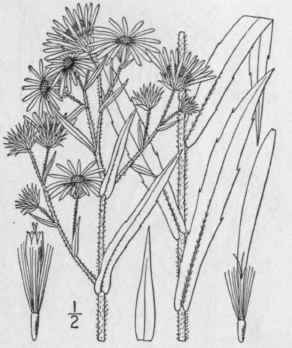31. Aster L. Sp. Pl. 872. 1753. Part 10
Description
This section is from the book "An Illustrated Flora Of The Northern United States, Canada And The British Possessions Vol3", by Nathaniel Lord Britton, Addison Brown. Also available from Amazon: An Illustrated Flora of the Northern United States, Canada and the British Possessions. 3 Volume Set..
31. Aster L. Sp. Pl. 872. 1753. Part 10
28. Aster Nebraskensis Britton. Nebraska Aster
Fig. 4309
Aster nebraskensis Britton, in Britt. & Brown, 111. Fl. 3: 375. 1898.
Stem strictly erect, slender, stiff, rough to the base, simple, or with a few short nearly erect branches, very leafy, 11/2°-21/2° tall. Leaves thick, rather rigid, ascending, lanceolate to oblong-lanceolate, entire, sessile by a subcordate base, acute or acuminate at the apex, 1'-3' long, 4"-6" wide, very rough on both sides, the midvein prominent beneath, the lateral veins obscure; heads few, terminating short leafy branchlets, 1'-1 1/4' broad; involucre broadly campanulate or hemispheric, about 3" high, its bracts green, oblong, acute, imbricated in several series, the outer quite foliaceous; rays purple, about 6" long.
Lake shores, central Nebraska. Sept. Lower and basal leaves not seen.
29. Aster Amethystinus Nutt. Amethyst Aster
Fig. 4310
Aster amethystinus Nutt. Trans. Am. Phil. Soc. (II) 7: 294. 1841.
Resembles Aster novae-angliae, but is often taller, sometimes 5° high. Leaves often crowded, linear-lanceolate, entire, rough or hispidulous on both sides, partly clasping, though sometimes slightly so, at the sessile base, acute at the apex, those of the stem 1'-2' long, 2"-3' wide; heads rather numerous, racemose or corymbose, 1/2'-1' broad; involucre broadly turbinate, its bracts much imbricated, linear, hispid, not glandular, the acutish green tips spreading; rays 20-30, blue or violet, about 3" long; pappus brown; achenes canescent.
In moist soil, Vermont and Massachusetts to New York, Pennsylvania, Illinois, Iowa and Nebraska. Sept.-Oct. Specimens have intermediate characters between Aster novae-anqliae L. and Aster multiflorus L., and hybridism is suspected.


30. Aster Modestus Lindl. Great Northern Aster
Fig. 4311
Aster unalaschensis var. major Hook. Fl. Bor. Am. 2: 7.
1834-Aster modestus Lindl.; Hook. loc. cit. 8. 1834. Aster majus Porter, Mem. Torr. Club 5: 325. 1894.
Stem stout, leafy to the summit, usually densely pilose-pubescent with many-celled hairs, rarely gla-brate, branched above, 4°-6° high. Leaves membranous, lanceolate, partly clasping by a narrowed base, acuminate at the apex, sharply serrate with low, distant teeth, dark green and slightly pubescent above, villous-pubescent on the veins beneath, 3'-5' long, 5"-10" wide; heads mostly solitary at the ends of short branches, 11/2' broad; involucre hemispheric, its bracts little imbricated, green, linear-subulate, densely glandular; rays 35-45, purple to violet, 5"-7" long; achenes appressed-pubes-cent; pappus tawny.
In moist soil, western Ontario to Minnesota, Oregon and British Columbia. Sept.-Oct.
31. Aster Puniceus L. Red-Stalk Or Purple-Stem Aster
Fig. 4312
Aster puniceus L. Sp. Pl. 875. 1753.
Stem usually stout, reddish, corymbosely or racemosely branched above, hispid with rigid hairs to glabrous, 3°-8° high. Leaves lanceolate to oblong-lanceolate, acuminate, sessile and clasping by a broad or narrowed base, sharply serrate, or entire, usually very rough above, pubescent on the midrib or glabrous beneath, 3'-6' long, 1'-1 1/2' wide; heads generally numerous, 1'-1 1/2' broad; involucre nearly hemispheric, its bracts linear or oblong, attenuate, imbricated in about 2 series, glabrous or ciliate, green, loose, spreading, nearly equal, sometimes broadened; rays 20-40, violet-purple or pale (rarely white), 5"-7" long, showy; pappus nearly white; achenes pubescent.
In swamps, Newfoundland to Ontario, Manitoba, Minnesota, Georgia, Tennessee, Ohio and Michigan. Races differ in pubescence, leaf-form and leaf-serration. Early purple aster. Swan-weed. Cocash. Meadow-scabish. July-Nov.


Continue to:


